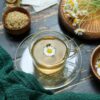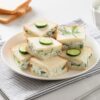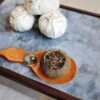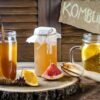
Derived from the leaves, buds, and stems of the Camellia Sinensis plant, Oolong tea is a traditional Chinese tea that deserves a rightful place in every tea lover’s collection. As a semi-fermented tea, Oolong tea is in a category of its own, distinct from the unfermented green teas and the fully fermented black teas. Its unique fermentation process results in a complex play of flavors and aromas that can be vividly floral, woody, fruity, or creamy depending on the precise level of fermentation and craftsmanship.
Oolong tea is renowned not just for its diverse flavor profile but also for its wide array of health benefits, ranging from boosting metabolism to improving heart health. It’s also a treasure trove of antioxidants, making it a potent ally in the fight against free radicals.
However, to truly appreciate the magic of Oolong tea, it’s important to understand its origins, its unique production process, and the different types available. This article will take you on a journey through the unveiled secrets of Oolong tea, its benefits, and brewing techniques.
The Origins and History of Oolong Tea
The story of Oolong tea began in the Fujian province of China, a region with a rich history in tea cultivation. The exact origins of Oolong tea are shrouded in mystery and folklore, with several legends attributing its creation to different historical periods. One such legend narrates the story of a tea farmer who was distracted by a river deer. By the time he returned to his tea leaves, they had started to oxidize, resulting in a unique aroma. The farmer decided to brew the tea and was delighted by the distinct flavor, thus giving birth to Oolong tea.
Another tale attributes the creation of Oolong tea to the Ming Dynasty, where it was developed as a tribute tea for the royal court. Regardless of its origins, Oolong tea has been an integral part of Chinese tea culture for centuries, and its popularity has spread far and wide.
Today, Oolong tea is cultivated in various regions worldwide, including Taiwan, Vietnam, and even the Darjeeling and Nilgiri regions of India. Each region’s unique geographical and climatic conditions contribute to the wide diversity of Oolong teas available in the market.
The Unique Process of Making Oolong Tea
Oolong tea’s distinct character lies in its unique production process, which is a perfect blend of artistry, tradition, and precision. The process begins with the plucking of mature tea leaves, which are then withered under the strong sun. This withering process allows the leaves to lose some of their moisture and become flexible for the next stage – bruising.
The bruising stage involves shaking or tumbling the leaves to break their cell walls, initiating the oxidation process. The level of oxidation in Oolong tea can vary between 8% to 85%, depending on the desired end product. This wide range of oxidation levels is what gives Oolong tea its diverse flavor profile.
Following oxidation, the leaves are then heated to halt the enzymatic process, a stage known as “fixing”. The leaves are then rolled and shaped, a step that can be repeated several times to achieve the desired leaf shape and enhance the tea’s flavor. Finally, the leaves are dried to preserve their aroma and taste.
The Different Types of Oolong Tea
Oolong tea is a diverse category with numerous types, each with its unique flavor profile. The variation in flavors stems from differences in the tea plant varietal, growing conditions, and the level of oxidation and roasting.
One of the most popular types of Oolong tea is Tie Guan Yin or Iron Goddess of Mercy. This tea is known for its floral and creamy notes and medium level of oxidation. Another commonly enjoyed variety is Da Hong Pao, a heavily oxidized tea with robust, woody flavors and a sweet aftertaste.
Other popular types include Oriental Beauty, a highly oxidized tea with honey-like sweetness, and Phoenix Dan Cong, a single-origin tea known for its ability to mimic the flavors of various fruits and flowers. Lastly, there’s the lightly oxidized and unroasted Baozhong tea, prized for its fresh and floral notes.
Health Benefits of Oolong Tea
Beyond its delightful flavors, Oolong tea is also celebrated for its numerous health benefits. Packed with antioxidants such as theaflavins, thearubigins, and EGCG, Oolong tea can help combat free radicals and reduce oxidative stress.
Regular consumption of Oolong tea has been linked to improved heart health. Studies have suggested that it can help reduce cholesterol levels and lower the risk of heart disease.
Oolong tea can also aid in weight management. It contains certain polyphenols that can help boost metabolism and reduce the amount of fat absorbed from your diet. Moreover, it’s believed to enhance mental alertness and performance, thanks to its moderate caffeine content and the presence of an amino acid called L-theanine, which has calming properties.
Brewing Techniques for Oolong Tea
When it comes to brewing Oolong tea, precision is key. The water temperature, quantity of tea leaves, brewing time, and even the choice of teaware can significantly impact the resulting brew.
For a standard 8oz cup of Oolong tea, use about one teaspoon of tea leaves. The ideal water temperature varies depending on the type of Oolong tea. Lightly oxidized Oolong teas are best brewed at lower temperatures, around 176-185°F (80-85°C), while darker, heavily oxidized Oolong teas can handle hotter water, around 194-203°F (90-95°C).
Brewing time also varies with the type of Oolong tea. As a general rule, lighter Oolong teas should be steeped for 1-3 minutes, while darker Oolongs can be steeped for 3-5 minutes. It’s also worth noting that Oolong tea leaves are often good for multiple infusions, with each subsequent infusion revealing new layers of the tea’s flavor profile.
Tips for Selecting and Storing Oolong Tea
Selecting a high-quality Oolong tea is crucial to enjoy its rich flavors and health benefits. Look for reputable tea brands that provide information about the tea’s origin, harvest date, and level of oxidation. The leaves should be whole and uniform in size, and the aroma should be fresh and clean.
Once you’ve selected your Oolong tea, proper storage is key to preserving its quality. Oolong tea should be stored in an airtight container away from light, heat, and moisture. It should also be kept separate from other teas and spices to prevent absorption of foreign odors.
How to Incorporate Oolong Tea into Your Lifestyle
Incorporating Oolong tea into your lifestyle can be as simple as swapping your regular morning or afternoon tea or coffee with a cup of Oolong. You might also consider hosting a traditional Chinese tea ceremony with Oolong tea, which can be a great way to unwind and connect with friends and family.
Beyond drinking it, you can also incorporate Oolong tea into your cooking. It can be used as a marinade for meats, a base for soups and broths, or even as a flavourful addition to desserts and cocktails.
Where to Buy High-Quality Oolong Tea
Finding high-quality Oolong tea is crucial for the best tea-drinking experience. Look for specialty tea shops or online retailers who source their teas directly from reputable tea gardens. Ensure that they provide detailed information about the tea’s origin, harvest date, and processing method.
The Unveiled Secrets of Oolong Tea
Oolong tea is a fascinating beverage with a rich history, diverse flavors, numerous health benefits, and complex brewing techniques. It’s a testament to the art and science of tea making, and a delightful journey of discovery for any tea lover. Whether you’re new to the world of Oolong tea or a seasoned connoisseur, there’s always something new to learn and appreciate about this remarkable tea. So go ahead, brew a pot of Oolong tea, and savor the unveiled secrets in every sip.






